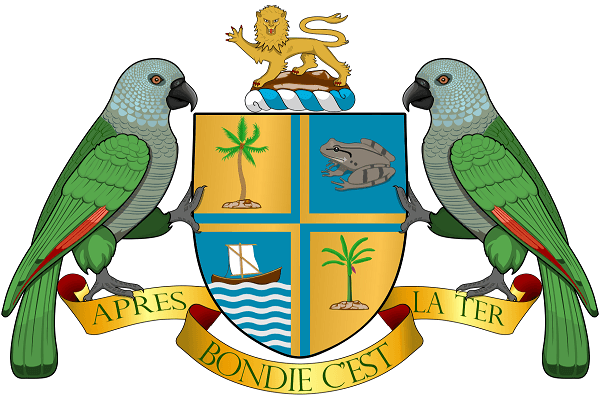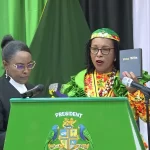Presidents of Dominica

The President of Dominica is the head of state while the Prime Minister is the head of government. The position of the president is largely ceremonial.
- Louis Cools-Lartigue
Louis Cools-Lartigue was the interim president of Dominica from November 1978 to January 1979. Born on January 5, 1905, Cools-Lartigue was formerly the Chief Secretary of the Westward Islands until May 9, 1955, when George F. Holsten made him Deputy Governor of Dominica.
He was the last governor of Dominica, having served between November 1967 to November 1978. He served as interim president after Dominica gained independence in 1978 until the parliament elected Frederick Degazon as president. However, the House of Assembly elected Cools-Lartigue as Dominican president after Frederick Degazon fled to England in June 1979 following a constitutional crisis.
But Cools-Lartigue served as elected president for just one day and then resigned the next day. It remains unclear if he resigned out of family pressure or due to protesters attack on his home on the day of his election. He died on August 21, 1993.
Jenner Armour became president after Cools-Lartigue left office.
- Frederick Eutrope Degazon
Frederick Eutrope Degazon was the first elected president of Dominica following the nation’s independence in 1978. He was born on January 4, 1913, in Castries, Saint Lucia.
Fred Degazon attended secondary school and college in Saint Lucia and later went to the University of London to study Law. He later returned home to the Caribbean in the 1940s and worked in various civil capacities in Saint Lucia, Jamaica, and Dominica before his retirement in 1969.
Members of Parliament elected him as Speaker of the House in 1977 and later as Dominica’s president after the island gained independence from Britain in 1978. But a constitutional crisis arose in June 1979 and Degazon fled to England from where he formerly resigned as Dominica’s president in February 1980.
The House of Assembly then elected Sir Louis Cools-Lartigue as Dominica’s president on June 15, 1979. But Cools-Lartigue resigned as president the day following his election, and Jenner Armour was elected as his replacement.
Degazon died on October 4, 2008 at the age of 95.
- Jenner Bourne Maude Armour
Jenner Bourne Maude Armour was the acting president of Dominica from 1979 to 1980. He was born on November 15, 1932, in Portsmouth and attended the University of London where he bagged a Master of Law degree. As a barrister in 1960, he worked in Anguilla, Trinidad and Tobago, Saint Kitts and Nevis, and then Dominica over a 40-year period.
Jenner Armour was made the acting president of Dominica in 1979 after the resignation of President Louis Cools-Lartigue. When President Fred Degazon who fled the country in 1979 to enable Cools-Lartigue to become president resigned in February 1980, Armour facilitated a new parliamentary election and he handed over power to Aurelius Marie whom the House of Assembly elected as Dominica’s president.
Armour later worked under Prime Minister Eugenia Charles as a minister of the Commonwealth of Dominica, and was later elected as deputy speaker of parliament in 1985. Between 1990 and 1995, he served in various capacities as Member of Parliament and later as attorney-general of the nation. He died on July 25, 2001, at the age of 68.
- Aurelius Marie
Aurelius John Lamothe Marie became the president of Dominica after being elected by the House of Assembly in 1980. Born on December 23, 1904, Marie studied Law and was called to bar before becoming a magistrate and jurist in Dominica.
Following his election as president by the House of Assembly on February 25, 1980, Marie became the second president of Dominica succeeding Acting President Jenner Armour. He was sworn in as president by Justice Cecil Hewlett and served as Dominica’s president for three years and was succeeded by Clarence Seignoret.
Aurelius Marie died on September 28, 1995.
- Clarence Seignoret
Sir Clarence Henry Augustus Seignoret was elected president of Dominica and served two consecutive terms in office. He was president from 1983 to 1988, and also from 1988 to 1993. Born on February 25, 1919 in Roseau, Seignoret attended Dominica Grammar School before proceeding to Saint Lucia to attend college.
He got employed as a civil servant in Dominica in 1936 before travelling to the UK in 1958 to undergo a two-year course at Oxford University. With necessary qualifications in international public service, Seignoret returned to Dominica in 1961 and took up employment with the government. He functioned as secretary in the Cabinet, and as acting president for some years.
In 1983, the House of Parliament elected him as president after President Aurelius Marie left office. He got re-elected to the presidency again in 1988 till 1993 when he resigned.
President Clarence Seignoret was awarded the Order of the British Empire (OBE) by Queen Elizabeth II; and was knighted with the Grand Cross of the Order of the Bath in 1985. In 1992, he was made Knight of Malta. He died on May 5, 2002.
- Crispin Sorhaindo
Crispin Anselm Sorhaindo was the president of Dominica from October 1993 to October 1998. Born on May 23, 1931, in the village of Vieille Case, Sorhaindo attended the Vieille Case Government School and later Dominica Grammar School. Between 1956 and 1957, he attended Trinity College in Oxford, northwest of London, and the Royal Institute of Public Administration, London, from 1963 to 1964.
Prior to the establishment of the House of Assembly in Dominica, Sorhaindo worked as the executive and legislative clerk between 1950 and 1973. He was the secretary of the Civil Service Commission set up for the Proposed East Caribbean Federation in 1963 and attended a London conference in 1966 for the independence of Dominica.
Sorhaindo also worked in various government positions and represented Dominica in many conferences that led to the establishment of CARIFTA, CARICOM, OECS, the CDB, and the CCM among others. Between 1973 to 1988, he worked at the Caribbean Development Bank in Barbados as bank secretary, director, and vice-president.
Sorhaindo was elected Speaker of the House of Parliament in 1988 and served for four years until he was elected the president of the country in 1993. He served as the president of Dominica for a single term which ended in 1998.
He was a committed member of the Roman Catholic Church and served in various capacities. In 1993, Papal Rome honoured him as the Knight Commander of the Order of St. Sylvester; and Queen Elizabeth II awarded him the Order of the British Empire in 1969. The Dominican government gave him the Dominica Award of Honour in 2001 after he had earlier received the naval medal Almirante Luis Brion award in 1998 from the government of Venezuela.
President Crispin Sorhaindo had a prolonged battle with cancer and died on January 10, 2010. He left behind six children and wife Ruby Allport.
- Vernon Shaw
Vernon Lorden Shaw was president of Dominica from 1998 to 2003. Born on May 13, 1930, he attended Dominica Grammar School before proceeding to the UK to study at the Trinity College, Oxford. He returned to Dominica in the 1960s and got employment with the government. He rose through the ranks to become Cabinet Secretary in 1977 among other attainments until he retired from public service in 1990.
Vernon Shaw joined politics under the United Workers Party (UWP). The House of Parliament elected him to become Dominica’s president in October 1998 after President Crispin Sorhaindo completed his term in office. Shaw was sworn in as president on October 6, 1998, and he served a single five-year term that expired in October 2003. He was replaced by Nicholas Liverpool as the nation’s president.
Vernon Shaw died on December 2, 2013, at the age of 83 years. He was married to Eudora Shaw (nee Massicott) and they had four children.
- Nicholas Liverpool
Nicholas Joseph Orville Liverpool was the president of Dominica from October 2003 to September 2012. Born on September 9, 1934, Liverpool schooled in Dominica before heading to the UK in 1957 where he obtained his Law degree in 1960 from the University of Hull. Called to the Inner Temple bar in 1961, he proceeded to the University of Sheffield where he got his Ph.D degree in 1965. The University of Hull gave him a Doctor of Laws degree in 2011.
Liverpool worked as a law lecturer at the University of the West Indies in Barbados and became the dean of the institution’s law school in 1992 before his resignation after 18 years at the university. He later became a regional judge and an appeal court judge in Grenada, Belize and other Caribbean countries. He worked on several commissions and tribunals for legal reforms after becoming a high court judge in Antigua and Montserrat. In 2002, he was appointed as chairman of the constitutional review commission in Grenada.
Between 1998 and 2001, Nicholas Liverpool was Dominica’s ambassador to the United States. He was on UNESCO’s governing board between 2002 and 2003. In October 2003, the House of Assembly in Dominica elected him as the nation’s president and he served till 2008 for his first term and from 2008 to 2012 for his second term in office.
Following a medical trip to the United States, Nicholas Liverpool died in a Florida hospital on June 1, 2015, at the age of 80. In 2012, His Royal Highness The Duke of Castro invested Liverpool with the Knight Grand Cross with Gold Star of the Sacred Military Constantinian Order of Saint George, and he was also the Vice Delegate of the Order for Dominica from 2014 until his death in 2015. He was buried in the cemetery of the Roman Catholic Church in Grand Bay. He was survived by wife Verna Liverpool and several children.
- Eliud Williams
Eliud Thaddeus Williams was the president of Dominica from 2012 to 2013. Born on August 21, 1948, Williams has an MBA from the University of the West Indies in 1995.
He was made Commissioner for Cooperatives in 1985 and served in that capacity till 1987. And in 1992, he became the Permanent Secretary at the Ministry of Health and Social Security till 1996 when he moved to the Ministry of Agriculture and Environment where he worked till 2000. He was also the chairman of the Rural Enterprise project from 1996 to 2000.
Eliud Williams was appointed Director-General of the Eastern Caribbean Telecommunications Authority in 2004 and he worked in that capacity till 2008. He also worked at the Ministry of Communications, Works, and Housing. Due to his business background, he was appointed a senior consultant for WHITCO and worked in the business planning department.
The Dominica Labour Party (DLP) presented Eliud Williams as their presidential candidate in 2012, and the House of Assembly elected him Dominica’s president on September 12, 2012. The United Workers Party (UWP) however boycotted the elections, citing electoral irregularities and constitutional abuse.
- Charles Savarin
Charles Angelo Savarin is the current president of the Commonwealth of Dominica. Born on October 2, 1943, in Portsmouth, he attended St. John’s Primary School and Dominica Grammar School before proceeding to England where he studied at Ruskin College in Oxford. He also has professional qualifications from Germany.
Savarin was a teacher at Dominica Grammar School from 1963 to 1970 before becoming a trade unionist with the Civil Service Association (CSA) where he served as general secretary for almost 20 years. He was a Senator during the interim government of 1979 to 1980 and played key roles as chairman of the Committee for National Salvation (CNS) which ensured that the interim government organized free and fair elections for an elected prime minister.
Savarin later got involved with the administration of Patrick John in which he played key government roles. In 1980, he contested the general elections on the platform of the Dominica Freedom Party (DFP) but lost to Mike Douglas. He was appointed a Minister without Portfolio in 1983 and tasked with the trade, industry and tourism industry.
The commonwealth government appointed him as Ambassador and Permanent Representative to the European Union in 1986. He was also the general manager of the National Development Corporation (NDC) before deciding to contest against Brian Alleyne when Dame Eugenia Charles stepped down from governance. Savarin lost to Alleyne, but then took the place of Eugenia Charles at the Roseau Central constituency.
He became the leader of the DFP in 1996 after the resignation of Alleyne, but he stepped down in 2007 due to overwhelming pressure from people. He represented Roseau Central in the House of Assembly and was re-elected the second in 2000. Following the coalition of the DFP with the Dominica Labour Party (DLP) led by Roosevelt Douglas, Savarin emerged the Minister for Tourism and later went on to become a key figure in Prime Minister Pierre Charles’ administration.
In 2003, Savarin in his capacity as acting prime minister proposed to construct a billion-dollar oil refinery in Castle Bruce area of Dominica, but the plan was scrapped when people opposed it on the grounds that drilling for oil would tarnish the image of Dominica as a Nature Island in its most pristine form.
When Roosevelt Skerrit was appointed as prime minister in 2004, his administration appointed Savarin as Minister for Foreign Affairs, Trade, and Labour in recognition of his contribution to the growth of the DLP following the coalition with DFP. He went on to become the Minister for Public Utilities, Ports and Public Service in 2008 following a cabinet reshuffle. He eventually joined the DLP fully before the 2009 general elections.
During his time as general secretary of CSA, he empowered the association to become a very strong trade union that carried our major strikes that almost crippled economic and government activities. One was that of 1973 and another was that of 1977.
His Excellency Charles Savarin was invested with the Knight Grand Cross award of the Sacred Military Constantinian Order of Saint George on November 5, 2014. He remains the incumbent president of Dominica. He is married to Clara Josephine Savarin and they are blessed with children.




